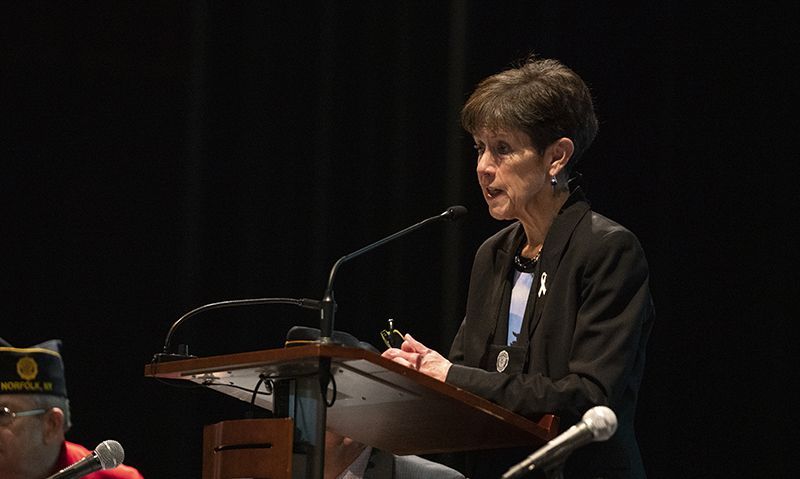
VA working to reduce COVID-19 vaccine hesitancy
Before a COVID-19 vaccine had received emergency approval to begin being used, the Department of Veterans Affairs already had begun developing a distribution plan. But Carolyn Clancy, VA’s Assistant Under Secretary for Health, said despite advance planning, her department’s distribution has still run into a roadblock: hesitancy on the part of veterans to receive the vaccine.
On Aug. 28 during its national convention in Phoenix, Clancy told The American Legion’s Veterans Affairs & Rehabilitation Commission that it’s critical for veterans to receive the vaccine and even asked for the Legion’s help in spreading that information.
“We’ve never had an extended public health emergency like this,” she said. “We’re at over a year and a half, and we don’t exactly know when this is going to end. It was great science to get to these effective vaccines, but that last mile is getting it into people’s arms – a challenge that I think is fair to say the country has underestimated.”
Clancy said VA had been proactive in generating confidence in the vaccines among its patient population, including hosting listening sessions for veterans of color “because we anticipated some challenges there. What they told us was that the information had to come from a trusted source. For many veterans, either that was their primary care doc or a fellow veteran.”
That’s where The American Legion comes into play. “For those of you who are vaccinated, thank you,” Clancy said. “You could not be doing more to protect yourself, your family members, fellow veterans and people you care about. If you have friends (and) colleagues contemplating (being vaccinated) but haven’t quite got there yet – particularly veterans who live in rural areas – I know what phenomenal work you do with other veterans. We count on you as indispensable partners, and I want to thank you for that.”
Clancy said easy access to the vaccine also came up during the discussions, as did the ability to schedule an appointment for the vaccine. VA issued Internet-connected devices to many veterans to communicate with them, and used its database to identify veterans eligible for the vaccine and schedule appointments for them.
Clancy said 70 VA facilities were a part of trials for at least one vaccine during Operation Warp Speed, a federal-driven collaboration between the private and public sectors to acceleration the development, manufacturing and distribution of COVID-19 vaccines, “which I think is something to be quite proud of,” said Clancy, also noting that VA already is working on distribution plans for any vaccine boosters.
Clancy also briefly touched on VA’s pilot program aimed at bringing care to a veteran’s home after an initial in-person visit at a VA facility: “Supporting Community, Outpatient, Urgent Care, and Telehealth Services” (S.C.O.U.T.S.) VA will send an Intermediate Care Technician (ICT) to a veteran’s residence to provide a digital consult that includes ensuring the veteran owns some form of a smart device and has a good Internet connection. The ICT will troubleshoot technical issues and can enhance the virtual visit with a digital stethoscope that allows doctors to virtually listen to heart health in real time.
“We often end up hospitalizing people who don’t necessarily need to have an in-patient experience,” Clancy said. “That puts them at some risk of getting an infection when they get in the hospital, to having a fall because they’re in a strange place.
“What we’re seeing (through the pilot program) is a significant decrease in hospital admissions from the emergency department. The most important aspect, in my view, is decreasing the risk.”
Michael Frueh, VA’s Principal Deputy Under Secretary for Veterans Benefits, said the Veterans Benefits Administration (VBA) has faced having to adapt its operations during the pandemic. But he pointed out that VBA recently completed its 1 millionth Compensation & Pension (C&P) exam earlier this year than any other year, has completed 5,000 personalized career guidance sessions with veterans, and recently guaranteed its 1.3 millionth VA home loan, its highest amount ever.
VBA has started doing C&P exams virtually and three quarters of the way through its fiscal year has delivered $93 billion in benefits, including disability compensation, educational and survivor benefits, and vocational rehabilitation.
Frueh said claims for new presumptions for Vietnam veterans dealing with the effects of toxic exposure began being processed June 21 – “the fastest we’ve ever implemented any type of Agent Orange presumptive,” he said. “For the Vietnam veteran and their survivors … who filed a claim before and was denied any of those presumptives … we’re reaching out to them. Veterans don’t have to file another claim. They don’t have to put in any other paperwork.”
Retired U.S. Army Maj. Gen. Matthew Quinn, now serving as the National Cemetery Administration (NCA) Under Secretary for Memorial Affairs, announced an expansion of the Veterans Legacy Memorial (VLM) project. The VLM is an online memorial space maintained by the NCA that provides a profile page for each veteran buried in a national cemetery. Family members and friends can add tributes, photos and memories to the profiles.
Quinn, a member of The American Legion Department of Montana, announced that on Veterans Day 2021, NCA plans to expand the VLM project to all 119 VA-funded state, territory and tribal cemeteries. It will expand the VLM’s reach to almost 4.5 million deceased veterans.
“That’s just the beginning. We want to be able to expand that to private cemeteries and locate those veterans buried in private cemeteries and create (profiles) for them,” Quinn said. “Yesterday I walked through D.C. and walked the Vietnam Wall. And I thought as I looked at individuals standing and recording a name, ‘that memory is exactly what VLM does for our veterans in an automated fashion.’ For our nation’s heroes, VLM, we believe, is the future of memorialization.”
